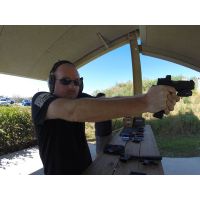I’ve reached a point in my life where I feel I’m pretty much excited about every new gun thing hitting the market, to the point nothing really stands out to me as particularly “got to have it” as I kind of want it all.
And then one morning recently, I came across a sweepstake contest from Springfield Armory to win a new Springfield Armory 1911 DS Prodigy 9mm pistol, and for some reason, the firearm really resonated with me as something I wanted.
My first impressions of the Prodigy from photos was it had that uber tacti-cool and serious look that I really wanted; a kind of high content, but subdued appearing pistol that kind of says, “This is a serious tool!”
This review is going to come in multiple parts - and I hope you’ll follow along on a journey of sorts, as I get to know the Springfield DS Prodigy.
With a little luck, my goal is to hopefully prove it out on the range as a reliable combat pistol, apply some modifications to it, and shuffle it into my every-day-carry rotation.
Springfield Armory 1911 DS Prodigy - Unboxing
Springfield DS Prodigy 1911 Overview
The Springfield Armory DS Prodigy is a double-stack, 9mm, 1911 pattern pistol, with your choice of 5” and 4.25” barrels, that ships optic ready, and can be purchased with an optional Hex Dragonfly red dot optic included.
The Prodigy features a polymer grip module fitted to a weighty forged lower receiver (with light rail) and it’s finished in black Cerakote.
It ships with a 17-round magazine and a 20-round magazine. There is an optional 26-round magazine available.
What’s notable is Springfield Armory has crafted a pistol that competes with the Staccato 2011 pistols at a lower price point.
Having handled both the Springfield Prodigy 5” and 4.25” models and several Staccato pistols side by side, I have to say I’m impressed with the feel of both of them and consider them comparable, for sure.
I will not say, or even hint, that the Prodigy is a better pistol than the Staccato 2011 - I haven’t shot both side-by-side and I haven’t lived with them as duty guns or everyday-carry guns.
But, considering I come from a background of coarse triggered, blocky Glock service pistols (that I love by the way) -
The Springfield DS Prodigy feels like a lot of gun, and a great value and a seriously competitive option for those looking for a Staccato without paying Staccato prices!
- Staccato P (4.4” barrel) Optic Ready
- $2399.00 + $159.95 for an optic mounting plate.
- Bul Armory SAS II TAC 4.25” & 5"
- $1890.00
- The Prodigy MSRP: $1499 (w/out optic)
- $1699 (w/ optic)
*The barrel length isn’t factored into the pricing
Video: Springfield Armory 1911 Prodigy
First Impressions
Damn! Where do I start?
There is a lot to be excited about here with such a feature-packed firearm at this price.
The grip? Okay! It’s aggressive but not too aggressive. It’s perfectly aggressive, in my opinion.
The grip texture is nowhere as coarse as the grip texture on my Gen 4 Glock 34 MOS, and the Prodigy’s fine grip texture is much more effective at keeping the gun firmly planted in the hand.
It feels kind of similar to, but not quite as aggressive, as skateboard tape used on the grip of a pistol.
I feel like it won't tear up my shirts if (after proving out its reliability) I start carrying the Prodigy concealed.
Next, fit and finish? Sure! Seems like a natural thing to consider next as you pick up the Prodigy, snick the thumb safety off, and work the slide.
The action feels buttery smooth and tight!
There is a feeling of quality here that I’m a little surprised by - but I may be just a little too used to unrefined, duty-carry pistols that sell for roughly half the price (or less).
How about the controls and the manual of arms?
For those familiar with 1911 pattern pistols, there is nothing new here. All the controls are located in the right places!
The Springfield DS Prodigy operates just like a normal 1911 and it’s awesome.




The Prodigy features an ambidextrous thumb safety that feels just right to me and seems substantially wide enough for me to ride it as a thumb shelf but not too wide to interfere with comfortable concealed carry.
Some people will understandably want something more substantial here, and being this pistol is 1911 in origin, different thumb safeties can be custom fitted.
Speaking of safeties, the grip safety on the Prodigy allows for a nice, high grip and engages easily.
The trigger is curved like most conventional 1911 triggers I’ve experienced with nice serrations on the face of it that give my trigger finger a nice purchase.
There is a short, but still perceptible, take-up before you hit the wall of pressure on the sear.
As you increase pressure on the trigger face, and the sear breaks, it’s almost perfectly crisp...almost.
It’s crisp enough that I’d characterize it as a huge improvement over the stock fighting triggers, I’ve become used to on Glock pistols.
The trigger weight is a little more than I would like on a 1911 range toy, coming in at an average pull of around 5 lbs., but for a combat pistol, it’s not bad at all.
Keep in mind, my main references are the Glocks I carried on my hip at work for sixteen years. I really enjoy the trigger reset on the Prodigy.
It’s short and distinct and begs for you to press off another round, dropping its skeletonized hammer over and over again!
The mag catch button seems to protrude from the grip module a substantial distance without it sticking out too far, but just far enough for it to be easy to hit, to drop a magazine quickly.
Some will want a mag catch with more surface area, and again, this can be sourced from the aftermarket and custom fitted.
The one control I’m not so crazy about is the slide catch lever.
In my opinion, it doesn’t protrude from the side of the pistol enough and is just too short to hit quickly and easily enough to release the slide in a combat-reload situation.
While I find I’m happy with all the other controls on my 4.25” example of the Prodigy, this is one thing I will most likely be seeking to improve.
The Prodigy Sights and Optics
My example of the Prodigy came with Springfield Armory’s Hex Dragonfly optic mounted.
A great feature of this pistol is that the optic plates (Agency Optics System, or AOS), co-designed by Agency Arms, have the rear sights integrated into them in dovetail sight channels.
My pistol had a slide blank plate included with an additional rear sight installed on that piece.
So effectively, one can say that the Prodigy ships with two rear sights, as each pistol includes an optic plate that fits the Hex Dragonfly optic whether you buy one with the optic or not.
The front sight has a green fiber-optic insert that is easy to pick up with the eye.
Both the front and rear sights are serrated to break up any light reflecting off of them that might distract or obfuscate your sight picture.


Back to the Hex Dragonfly Optic
I entered the world of serious pistol combat optics with the Trijicon RMR, mounted to my Glock 34 MOS.
I like the Trijicon RMR as it’s a seriously rugged RDS (Red Dot Sight) and my example has seen some tough range days through a part of my career as a law enforcement firearms instructor as well as duty use getting slammed and banged on things.
I also love my Holosun 507C that I carry on my occasional EDC Glock 19.
The Holosun 507C may not be as rugged as the Trijicon RMR, but its convenience features such as the side-load battery, shake awake power function, and solar backup makes it a really nice option for me.
So, basically - I’m largely comparing the Hex Dragonfly to those two optics.
The body of the Hex Dragonfly feels decently robust and I feel like it could take a couple of serious licks without the optic failing.
The rear surfaces of the Dragonfly are serrated; a nice feature for breaking up any light that might otherwise reflect back toward the shooter.
One really nice feature of the Hex Dragonfly is the rear-most nubs that protrude from the back of the optic which provides a nice area to grip for cycling the slide by hand.
The dot is 3.5 MOA in size and is easy to find with the eye when presenting the weapon on target.
The red dot’s features are all controlled with a single button on the left side of the Dragonfly.
One press turns the optic on to full power. Quick presses turn the intensity of the red dot down.
One long press turns the optic off. The optic will stay powered on, according to Springfield Armory, for roughly 100,000 hours on its battery while set to the lowest setting.
There are some things I really don’t like about the Hex Dragonfly and one of these things in that 3.5 MOA dot. It’s very coarse and fuzzy (to me)
I also find it to be made up of a handful of smaller, randomly placed dots - Long story short, it’s just a little messy looking to my eye.
Another big dislike to me is the feel of the single button that controls the functions.
It feels a little too soft and squishy, and I feel like any hard use is going to see the button pop off, leaving the inside workings of the sight susceptible to water and dirt intrusion.
I’m left wondering if it should feel a little more robust and if it might prove to be an issue with hard use.
And the last thing I don’t like about the Hex Dragonfly is the fact that to change the battery, you have to remove the whole RDS off the gun to access the battery.
I don't like this about the Trijicon RMR too! I am very concerned about the zero shifting when removing and remounting optics, but on the plus side, re-zeroing an optic means more range time.
Assorted DS Prodigy Photos
Summary / Saved Rounds
In the next installment of my Springfield Armory DS Prodigy review, I will be giving you my impressions of this thing after some range time as I evaluate whether or not my Prodigy will be a viable option to enter my EDC gun rotation.
I’m really interested in finding out if some of the negative aspects and complaints about the Prodigy rear their ugly head - there have been complaints of tight chambers, failures to feed, failures to extract, and some believe it’s an over-sprung gun.
I’m looking forward to sharing my thoughts on this with you and I hope you will continue on this journey with me!
WANT MORE ON THE 1911 PRODIGY?
Like what you've seen and read so far? Check out our followup article:







